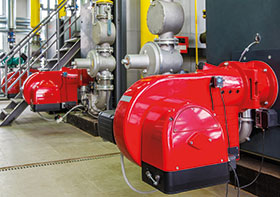

Fired equipment such as heaters and boilers normally have to comply with either NFPA 85/86 or API 556 for North America, and some other countries which apply such standards, or EN 746-2 for Europe and countries that adopt the European standards, or SANS 329 for South Africa (which was originally the same as EN 746-2). Although SANS 329 specifically deals with installation equipment and burner management system (BMS) safety standards required to ensure safe start-up, operation and emergency shutdown (ESD), stable firing control is required to maintain operational safety as well as operational efficiency. Historically, there have often been problems in starting burners, especially when the furnace is cold, with operators having to resort to their own best methods to achieve a successful light-off, such as cracking open hand valves to control burner fuel pressure or venting fuel gas to achieve stable header pressure until a number of burners have been lit. The primary culprit for this is the rangeability of the fuel gas control valve turndown.
Fuel gas control options
There are four options for fuel gas control which vary in cost and operating complexity, some providing excellent start-up controllability, depending on the burner configuration. These can be summarised as:
• Option 1 – single control valve.
• Option 2 – split range control valves.
• Option 3 – control valve with self-regulating valve.
• Option 4 – control valve with restriction orifice.
These four options are discussed in more detail, indicating the pros and cons of each application in the main article.
DCS graphics display
The control room operator is in close communication with the field operator at the local control panel (LCP) during start-up, the LCP contains the same burner status information plus the block valve operating pushbuttons, including the block valve leak test (valve proving system) and purge cycle controls. It is important that the fuel gas controls and burner operation have good ergonomic operator graphic displays, specifically for start-up or when on reduced load. This also applies to option 2 on split range control. It is often required, due to the low burner pressure turndown during start-up or when on low load, to have a lower trip transmitter range for the low gas pressure trip, e.g. 0 to 1 bar, than for the high gas pressure trip transmitter which may be 0 to 3 bar.
Fuel gas pressure override
It has been mentioned in the introduction about the problems during start-up, due to controlling low fuel gas pressure when lighting the first few burners and the turn-down or rangeability of the fuel gas control valve. The real issue, which causes most operator problems during start-up, is the tripping of the fuel gas block valves due to fuel gas header instability and reaching the high or low fuel gas pressure trip setting due to fluctuations in the fuel gas header while trying to light the first few burners.
If the fuel gas control valve does not have the turndown rangeability to light the first few burners, then the fuel gas header may reach the fuel gas supply pressure. A number of solutions can minimise this problem – one is to open the fuel gas header vent valve until a few burners are lit, but this wastes fuel and may be in contravention of the environmental regulations. The other option is to override the fuel gas pressure trip, which is mostly used today. The override can be manually initiated, but this has the disadvantage of the operator having to remember to remove the override as soon as possible. So the preferred method is to initiate and remove the override via the BMS logic at the optimum time. This action then becomes transparent to the operator during start-up.
Interested readers can find the full article at http://instrumentation.co.za/+J1686
For more information contact RJ (Dick) Perry, +27 (0)83 641 0799, [email protected]

© Technews Publishing (Pty) Ltd | All Rights Reserved